cost a lot of time and money.
of UFM please GIVE A DONATION!
UFM APPLICATIONS
The power of Ultimate File Manager is appropriately configured file manager that is enriched with the best plug-ins to extend its functionality and carefully selected external programs. Ultimate File Manager consists of many components that work together. Total Commander file manager (or its free equivalent Multi Commander) is the central and most important component. Their work is complemented by special applications that ensure the correct operation of the entire project. Each of them is designed for a specific use, performing strictly defined tasks. This document describes UFM App Manager application.
UFM APP MANAGER
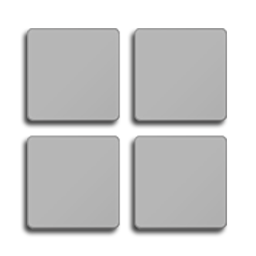
| Author: | Paweł Porwisz |
| License: | Freeware |
| Copyright: | Copyright © 2016 - 2025 Paweł Porwisz |
| Application Name: | UFM App Manager (AppManager.exe) |
| Configuration File: | AppManager.ini | AppManagerData.ini |
UFM App Manager (AppManager.exe) is a program that allows you to open or edit files with a specific extension (file type) in selected application, previously defined by the user. It is Ultimate File Manager project component and works with Total Commander and Multi Commander File Managers.
Total Commander File Manager and Multi Commander File Manager support File View and File Edit actions. With UFM App Manager you can customize the viewing/editing of different types of files in different applications. This allows you to create associations of files with a given extension with a specific application, independent of the operating system.
File View action is activated by pressing the F3 key on the keyboard (or F3 View button on the Function Key Bar). File Edit action is activated by pressing the F4 key on the keyboard (or F4 Edit button on the Function Key Bar). UFM App Manager (an external viewer/editor for File Manager) interprets these commands appropriately and launches the appropriate program for the given file extension.
By pressing Alt + F3 key combination, we invoke Total Commander's internal browser (Lister) for files under the cursor in the active panel list. By pressing SHIFT + F3 key combination, we invoke Total Commander's internal browser (Lister) for all selected files on the active panel list. These options can be set in Total Commander File Manager Configuration window, on the Edit/View tab.
UFM App Manager application (AppManager.exe executable file)must be locatedin the root directory of Ultimate File Manager project. Depending on the type of installation, these are by default:
- Installation version: %ProgramFiles%\UFM
- Portable version: %USERPROFILE%\Desktop\UFM
UFM App Manager application works correctly in Windows 7/8/10/11. It supports 32/64-bit architecture. UFM installer copies a file with the appropriate architecture depending on the architecture of the operating system used. This program worksonlywith Ultimate File Manager - it uses the common project environment and can't be run separately (if you want to use it outside Ultimate File Manager, use its special version Total Commander Editor.
UFM App Manager must be registered in Total Commander/Multi Commander File Manager. UFM installer adds all appropriate entries to the configuration files during installation.
-
Total Commander File Manager configuration file: \TC\CONFIG\TC.ini
[Configuration]
Viewer=""%COMMANDER_PATH%\..\AppManager.exe" /OPEN"
Viewertype=2
Editor=""%COMMANDER_PATH%\..\AppManager.exe" /EDIT"
-
Multi Commander File Manager configuration file: \MC\UFM\1033\CustomKeymappings.xml
<keymap>
<map extid="" ctrl="0" udc="a568468079cb4dc5b5123487d908e891" key="F3" keymod=""/>
<map extid="" ctrl="0" udc="a568468079cb4dc5b5123487d908e892" key="F4" keymod=""/>
</keymap>
For proper operation, the program uses text configuration files in INI format. These are:
-
File: AppManager.ini
This configuration file stores all program settings. It is necessary for its proper operation.
-
File: AppManagerData.ini
This configuration file stores the settings of all predefined UFM applications and other programs added by the user. It specifies the path to the program, its description, command line parameters, startup mode (normal, minimized, maximized), keyboard shortcut, number of launches and all supported extensions.
-
File: AppsInfo.ini
This configuration file stores descriptive data of the program, divided into language version.
UFM App Manager also uses project configuration files (UFM.ini/install.ini) and libraries (Images.dll/Styles.dll/UFMShell.dll). Depending on the installation type of Ultimate File Manager project, configuration files are stored in different locations.
- Installation version (user data directory): %LOCALAPPDATA%\UFM
- Portable version (main project directory): %USERPROFILE%\Desktop\UFM
UFM App Manager program is universal and can operate in several modes, fulfilling various tasks, depending on how it is launched. You can run the program in default mode (Application Manager), in File View mode (F3), in File Edit mode (F4), in Directory Information mode (F3) and by using Windows Shell Extension Library.
• Application Manager
UFM App Manager program is launched directly in the File Manager (no parameters are passed on the command line). In this mode we can manage applications. We can run them, add new applications, edit existing ones or delete them. We can check information about each of them. We can assign file extensions to a given application for which it will be launched (in File View mode [F3] or File Edit mode [F4]). This program allows you to customize the way applications are displayed on the list (list style and icon size) and their sorting (sorting by alphabetical order and by the number of launches is available).
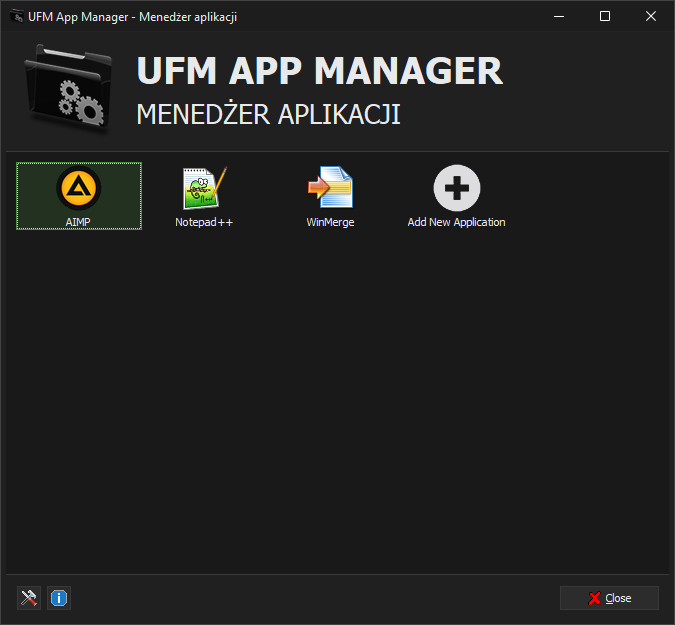
Ultimate File Manager is distributed with many predefined applications (UFM contains basic applications, while the extended version of the installer, UFM MEGAPack, contains much more of them). They are all displayed in a list (offering predefined settings for supported file extensions).
In Application Manager mode, we have access to all settings that allow us to customize the appearance and functionality of the program. To adjust the program options, use the context menu (right-click on the program icon / empty list field) or use the "Settings" button located in the footer (usually a context menu, because the footer and the program header can be hidden).
Application context menu has the following items:
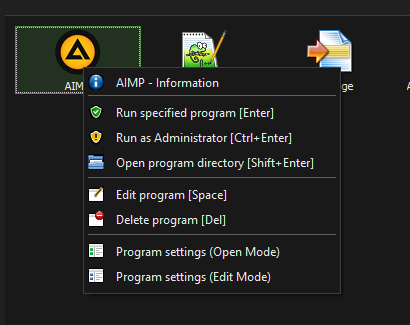
-
Information
This command allows you to display information about the program.
-
Run specified program [Enter]
This command allows you to run selected program (you can also do it by double-clicking the program icon or using the Enter key). After starting the program, UFM App Manager application closes (depending on the option).
-
Run as Administrator [Ctrl + Enter]
This command allows you to run selected program with Administrator privileges (you can also do it by using the Ctrl + Enter keyboard shortcut). After starting the program, UFM App Manager application closes (depending on the option).
-
Open program directory [Shift + Enter]
This command allows you to open application directory in Windows File Explorer.
-
Edit program [Space]
This command allows you to open Edit Program dialog box (you can also do it using the Space key). You can change all required information about the application (Program name, program path, program description, command line parameters, startup mode (normal, minimized, maximized) and keyboard shortcut).
-
Delete program [Del]
This command allows you to remove application from the list. You must confirm this decision.
-
Program Settings (Open Mode)
This command allows you to open File Open Mode dialog box (F3). You can manage file extension settings that are supported in the program. You can add/edit or remove file extensions and set the appropriate action for each of them (Directly opening a file with a given extension in the program or Opening the program selection window) and command line parameters (by default, %1, which represents passed files to be opened).
-
Program Settings (Edit Mode)
This command allows you to open the File Edit Mode dialog box (F4). You can manage file extension settings that are supported in the program. You can add/edit or remove file extensions and set the appropriate action for each of them (Direct editing of a file with a given extension in the program or Opening the program selection window) and command line parameters (by default, %1, which represents files passed for editing).
UFM App Manager program context menu has the following items:
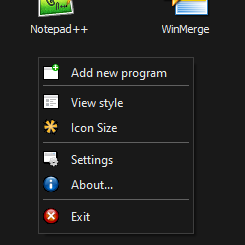
-
Add new program
This command allows you to add a new program to the list and determine all required information about the application (Program name, path to the program, program description, command line parameters, startup mode (normal, minimized, maximized) and keyboard shortcut).
-
View style
This command allows you to set the style of the application list. You can display programs in the list as icons, as small icons, in list or report form. You can also decide whether you want to display application icons (loaded from application file or from the Cache) or not (then the default icon will be displayed).
-
Icon Size
This command allows you to set the size of application icons on the list (only in icon display style). You can use several icon sizes (16x16 (small), 32x32 (large), 48x48 (very large) and 256x256 (large)).
-
Settings
This command allows you to display the "Settings" dialog box, where you can set all program options.
-
About...
This command allows you to display the "About..." dialog box, where you can read about the program.
-
Exit
This command allows you to close the program.
• File View (F3)
UFM App Manager application is launched in File Manager using the F3 key (the selected files on the list of the active File Manager panel are passed in the command line). File View mode is intended to immediately open the selected file (or files) in a predefined application. If no predefined application is associated with a given extension (file type), a window is displayed with a proposal of programs that can handle a given file type. All programs are displayed on a list and are divided into categories:
-
Preferred Applications
This section displays all programs that support files with the selected extension (file type), but do not open them directly. Clicking on any of them (or pressing Enter or Ctrl+Enter in Administrator mode) opens the file in that program. You can define the behavior for each application extension in the options. You can also select any other application from the disk by clicking the "OTHER PROGRAM" icon.
-
Other Applications
This section displays all other programs added by the user. Clicking on any of them (or pressing Enter or Ctrl+Enter in Administrator mode) opens the file in that program and automatically sets that program to the preferred program for that file extension.
-
System Associated
This section displays the program that is associated with the given file extension in the Windows operating system (if there is no such association, the program displays the "Open With" dialog box built into the operating system).
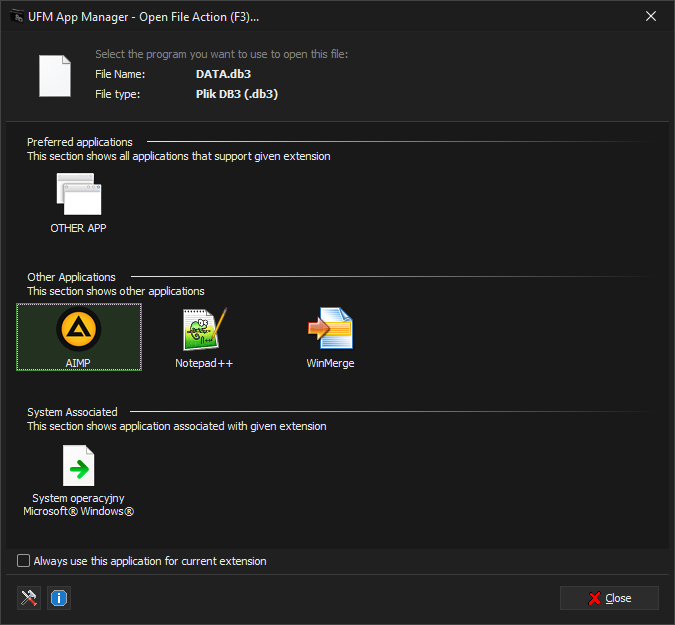
File View mode (F3) provides options that allow you to manage the application and supported file extensions. You can use the application context menu (right-click on the application icon), program context menu (right-click on the list) or the Settings button (located in the footer).
Application context menu (available by right-clicking on the application icon) has the following items:
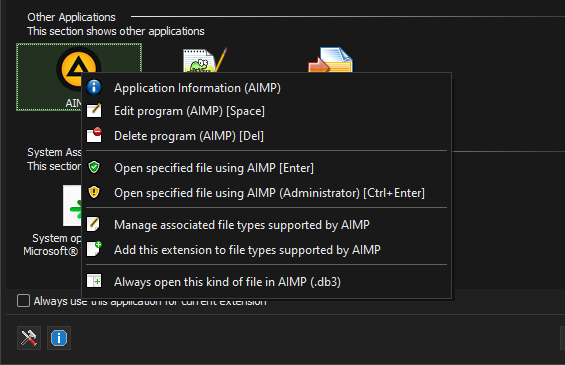
-
Application Information
This command allows you to display information about the program.
-
Edit program [Space]
This command allows you to open Edit Program dialog box (you can also do it using the Space key). You can change all required information about the application (Program name, program path, program description, command line parameters, startup mode (normal, minimized, maximized) and keyboard shortcut).
-
Delete program [Del]
This command allows you to remove a program from the list. You must confirm this decision.
-
Open specified file using program [Enter]
This command allows you to run selected program (you can also do this using the Enter key). After starting the program, UFM App Manager application closes.
-
Open specified file using program (Administrator) [Ctrl + Enter]
This command allows you to run selected program with Administrator privileges (you can also do it by using the Ctrl + Enter keyboard shortcut). After starting the program, the UFM App Manager application closes.
-
Manage associated file types supported by program
This command allows you to open File Open Mode dialog box (F3). Here you can manage the file extension settings that are supported in the program. You can add/edit or remove file extensions and set the appropriate action for each of them (Directly opening a file with a given extension in the program or Opening the program selection window) and command line parameters (by default, %1, which represents passed files to be opened).
-
Add this extension to file types supported by program
This command allows you to add a file extension (file type) to the file types supported by the application (application becomes the preferred program for a given file type). If a file extension is already associated with a program, you can remove it from the list of supported application extensions.
-
Always open this kind of file in program
This command allows you to add a file extension to the list of extensions supported directly by the program and open it directly (without displaying program selection window).
UFM App Manager context menu (available by right-clicking on the list) has the following items:
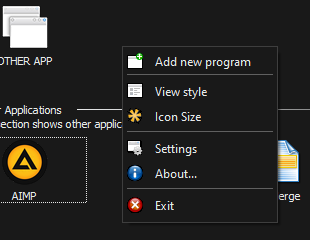
-
Add new program
This command allows you to add a new program to the list and determine all required information about the application (Program name, path to the program, program description, command line parameters, startup mode (normal, minimized, maximized) and keyboard shortcut).
-
View style
This command allows you to set the style of the application list. You can display programs in the list as icons, as small icons, in list or report form. You can also decide whether you want to display application icons (loaded from application file or from the Cache) or not (then the default icon will be displayed).
-
Icon Size
This command allows you to set the size of application icons on the list (only in icon display style). You can use several icon sizes (16x16 (small), 32x32 (large), 48x48 (very large) and 256x256 (large)).
-
Settings
This command allows you to display the "Settings" dialog box, where you can set all program options.
-
About...
This command allows you to display the "About..." dialog box, where you can read about the program.
-
Exit
This command allows you to close the program.
• File Edit (F4)
UFM App Manager application is launched in File Manager using the F4 key (selected files on the list of active File Manager panel are passed in the command line). File Edit mode is intended to immediately open selected file (or files) for editing in predefined application. If no predefined application is associated with a given extension (file type), a window is displayed with a proposal of programs that can handle a given file type. Programs are displayed in a list and divided into categories.
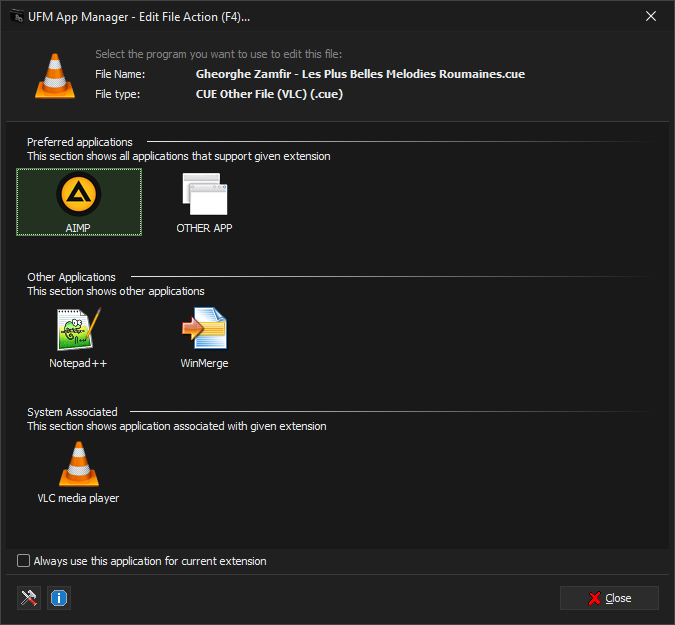
File Edit Mode (F4) works on the same principle as File Viev Mode (F3). However, the main difference is the way the file is handled. For example, a file with the extension mp3 (compressed audio file) can be played in a media player or edit the audio track in a specialized program.
You can therefore set the UFM App Manager program so that the audio file is opened and played in the AIMP media player (by checking file in the list of active panel of File Manager and pressing F3 key) or edited in the Audacity (by selecting file in the list of the active panel of File Manager and pressing F4 key).
• Directory Information (F3)
UFM App Manager application is launched in File Manager using F3 key (all selected directories on the list of active File Manager panel are passed in the command line). The Directory Information Mode is intended to display basic information about a directory/disk along with a graphical representation of the data (pie or line chart).
The following information about Directory is available:
- Directory Name
- Directory Path
- Directory Location
- Type
- Number of files
- Number of Folders
- Creation date
- Modified date
- Attributes
- Disk Capacity
- Disk Free Space
- Directory Size
- Other Content
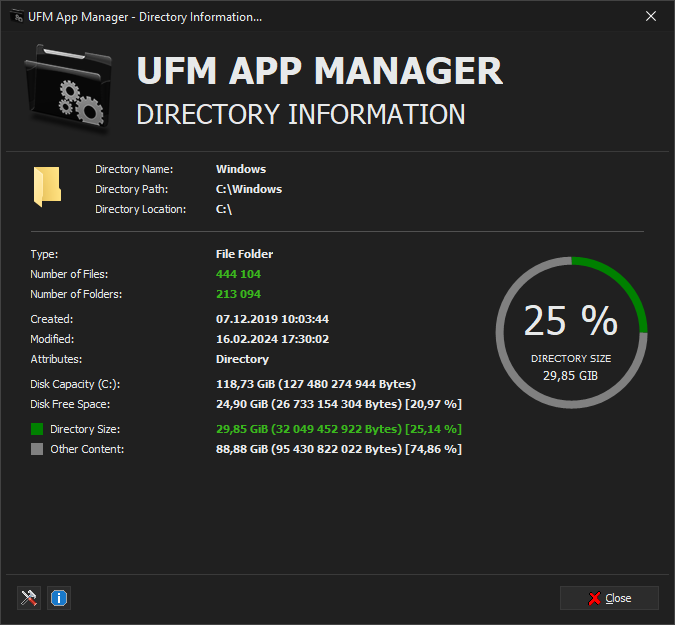
You can also view Disk information.
- Drive Letter
- Disk Name
- Disk Type
- File System
- Disk Capacity
- Disk Used Space
- Disk Free Space
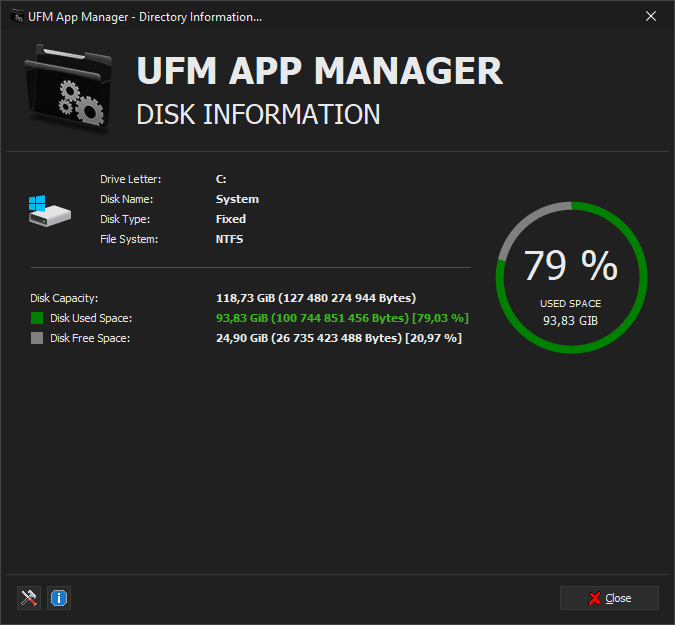
It is also possible to display information about more than one directory/disk. Selecting multiple items in the active File Manager panel list displays them in the list and selects the first one. Just select a directory/disk on the list and the appropriate information will be displayed.
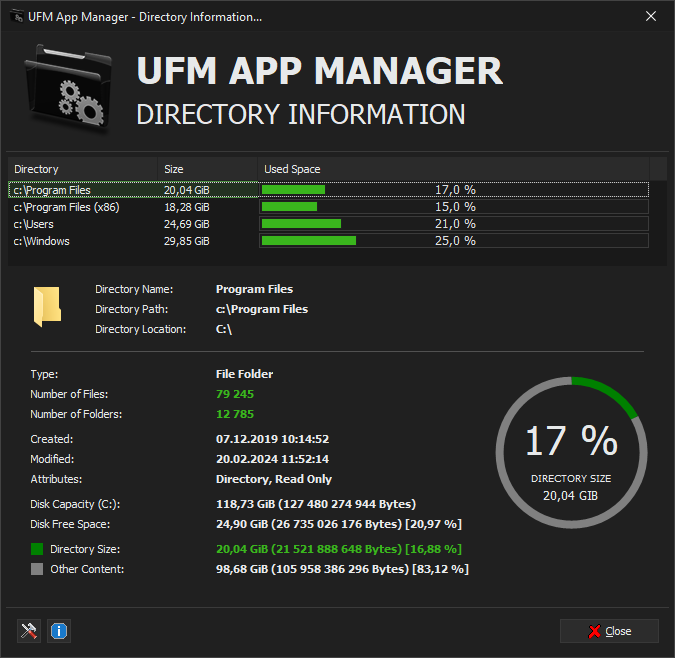
Directory Information Mode (F3) provides context menu options (right-click) that allow you to perform several actions:
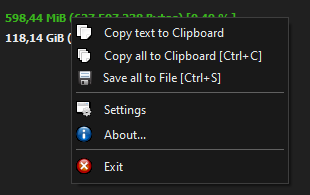
-
Copy text to Clipboard
This command allows you to copy specific information to the Windows clipboard (option available only after right-clicking on the information text).
-
Copy all to clipboard (Ctrl + C)
This command allows you to copy all information to the Windows clipboard (option available by right-clicking in the window workspace). You can use a keyboard shortcut Ctrl + C.
-
Save all to File (Ctrl + S)
This command allows you to save all information to a file on disk (option available by right-clicking in the window workspace). You can use a keyboard shortcut Ctrl + S.
-
Settings
This command allows you to display the "Settings" dialog box, where you can set all program options.
-
About...
This command allows you to display the "About..." dialog box, where you can read about the program.
-
Exit
This command allows you to close the program.
• Windows Shell Extension Library
UFM App Manager works with Ultimate File Manager Windows Shell Extension Library (UFMShell.dll). Windows Shell Extension is a COM object that extends the functionality of the standard Windows Shell - Windows Explorer. Shell extensions are divided into two types:
-
Shell Extension Handlers
Extensions that the system shell polls when certain events occur. They enable, among other things, the creation of additional icons depending on the state of a given file, and the expansion of the menu - both the context menu and the one occurring during file dropping events.
-
Namespace Extensions
They allow you to create virtual folders within which the extension creator can partially control individual parts of the Windows Explorer interface, such as menus, toolbars, status bar, tree view (on the left) and folder view (on the right).
With this extension, you can use the File Explorer context menu and open Files or Directories in Total Commander or Multi Commander File Manager. This functionality is only available in Normal UFM Installation (Portable Installation does not interfere with the user's operating system).
To use this functionality, Windows Shell Extension Library must be registered in Windows. The library is copied and registered automatically by Ultimate File Manager Installer (if user selects the appropriate option). You can also do this at any time in the UFM Shell Integration application (ShellIntegration.exe). The Windows Shell Extension Library is copied to the UFM installation directory, by default: %ProgramFiles%\UFM\LIB\UFMShell.dll
You can also register/unregister the library manually (Advanced users only) using the Windows utility - Regsvr32. This is a command-line tool for registering and unregistering OLE controls, such as DLL controls and ActiveX controls, in the Windows registry. To manually register a control in Windows 7+, click Start, type Command Prompt or cmd in the Search box, right-click Command Prompt, and then click Run as Administrator. If you are asked to confirm or enter an administrator password, type the password or click Allow.
To register a control, type the following command:
Regsvr32 "%ProgramFiles%\UFM\LIB\UFMShell.dll"
To unregister a control, type the following command:
Regsvr32 /u "%ProgramFiles%\UFM\LIB\UFMShell.dll"
Ultimate File Manager Shell Extension provides an "Open with Ultimate File Manager" context menu entry. By calling the context menu for a directory in File Explorer, we can open this directory in the Total Commander or Multi Commander File Manager.
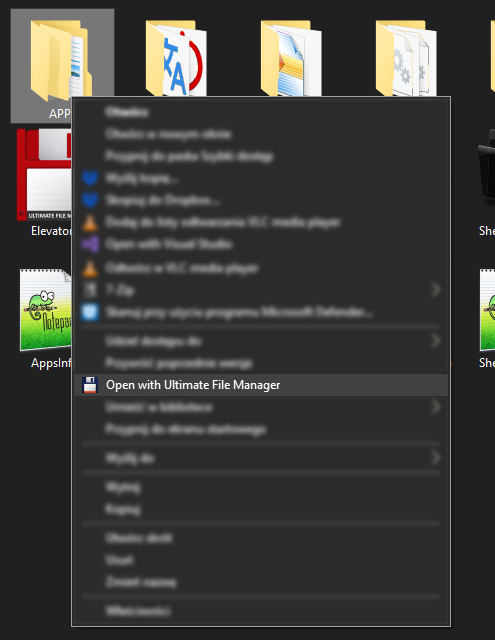
By calling the context menu for a File in File Explorer, we can perform several actions:
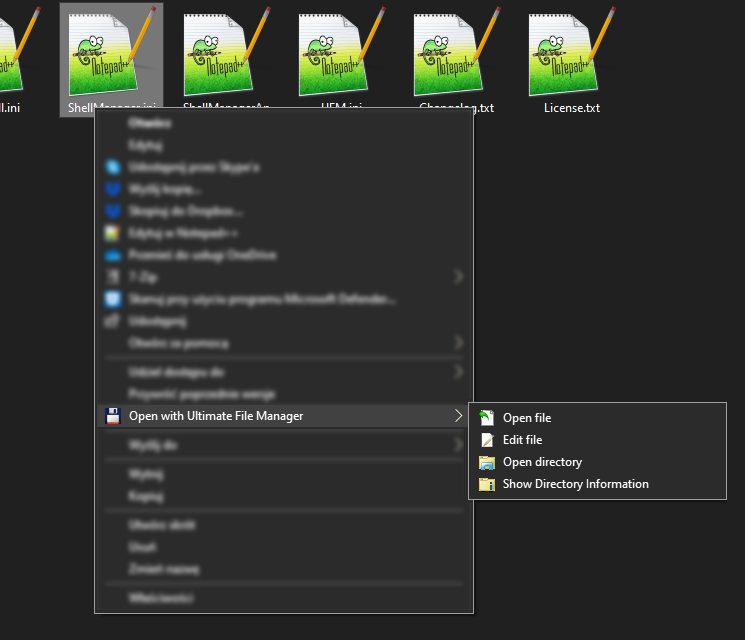
-
Open file
This command allows you to open a file selected in File Explorer in the application associated with that file extension (or another application selected from the list if the file extension is not associated with any application). This command corresponds to the File View (F3) command in UFM App Manager.
-
Edit file
This command allows you to edit a file selected in File Explorer in the application associated with that file extension (or another application selected from the list if the file extension is not associated with any application). This command corresponds to the File Edit (F4) command in UFM App Manager.
-
Open directory
This command allows you to open Directory (where the selected file is located in File Explorer) in the Total Commander or Multi Commander File Manager.
-
Show Directory Information
This command allows you to display information about Directory (where the selected file is located in File Explorer). This command corresponds to the Directory Information (F3) command in UFM App Manager.
OTHER APPLICATIONS
You can also learn more about the other UFM applications. They are listed all below.